Analyzing undergraduates’ needs for an improvement in interpreter training curriculum at banking university HCMC, Vietnam
This paper aims to analyze students’ needs for an improvement in interpretation
course design, administered among 96 seniors from the Faculty of Foreign Languages at
Banking University of Ho Chi Minh City (BUH), Vietnam. It used a questionnaire on
learning objectives, course planning, teaching contents, teaching methods, testing and
evaluation in this institution. The results indicated that the students would like to get good
marks in the final exams as well as acquire necessary knowledge and skills of a real
interpreter. The findings also revealed that there should be more authentic practice, groupwork activities, and practical collaborative evaluations. The topic selection and teaching
methods need to take learners’ interests and effective formal class time into account.
Finally, the results showed that the students lacked confidence in their interpreting ability;
therefore, instructors should spend more time on practice and practical implications should
be considered for subsequent course curriculum updates.
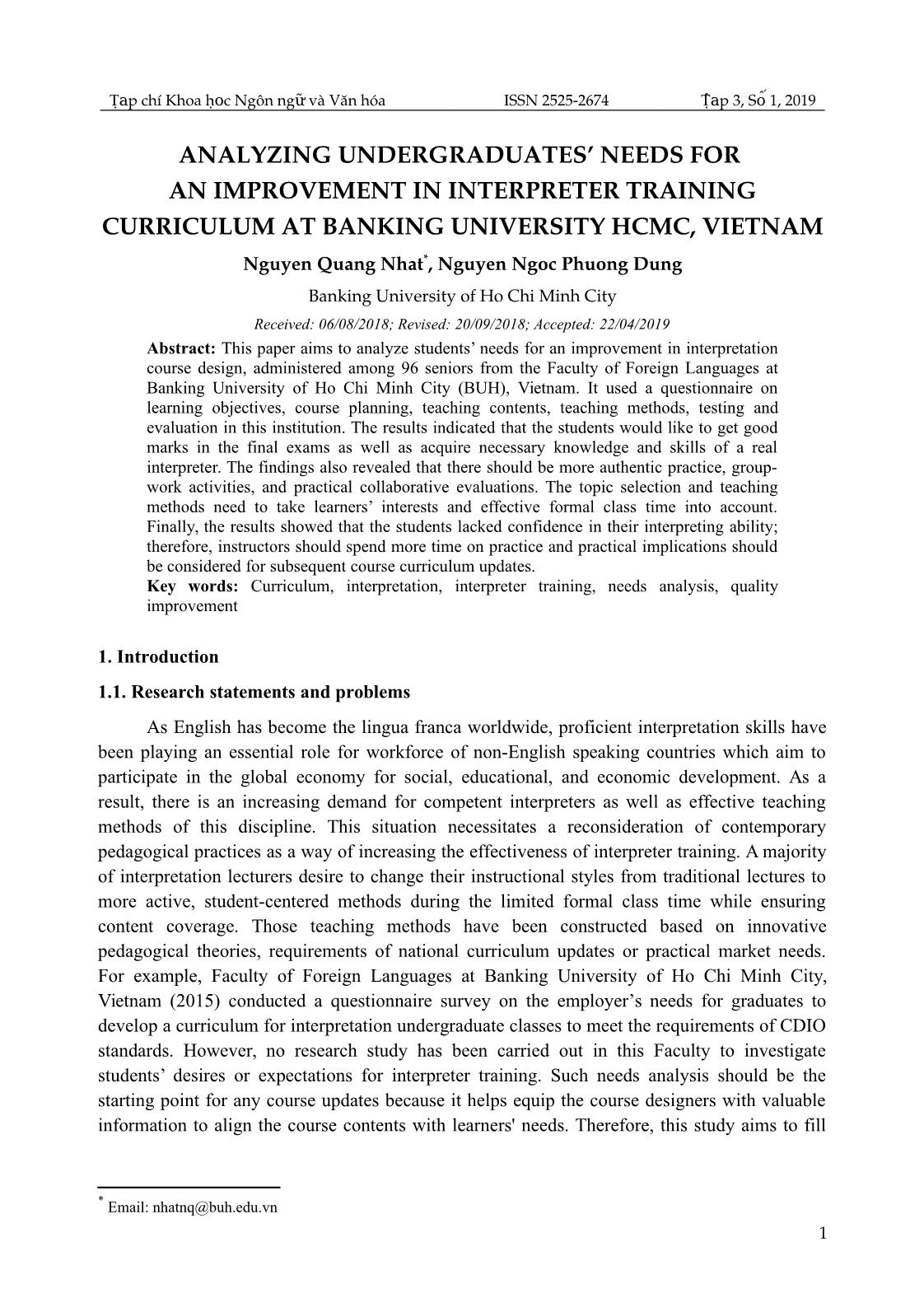
Trang 1
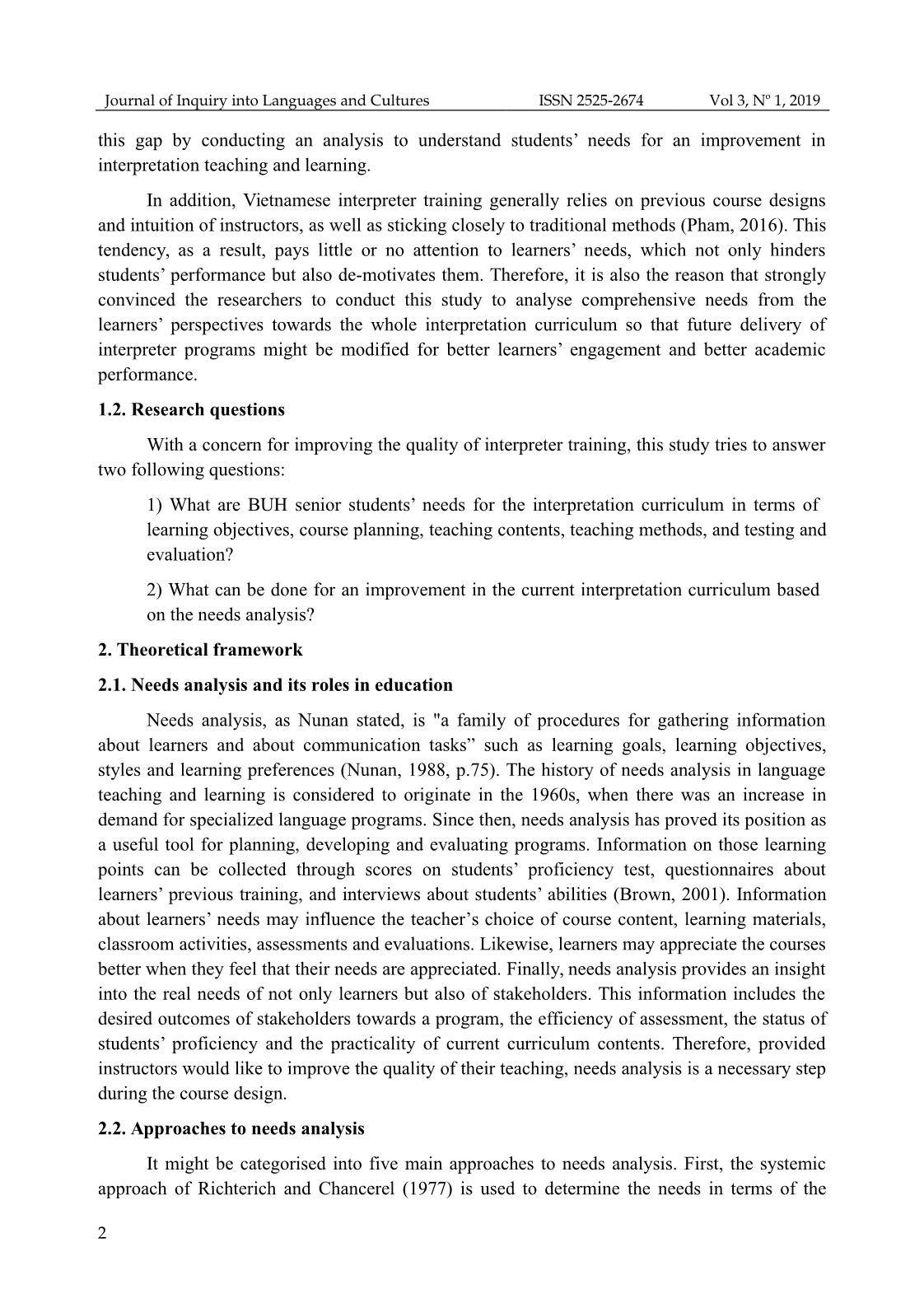
Trang 2
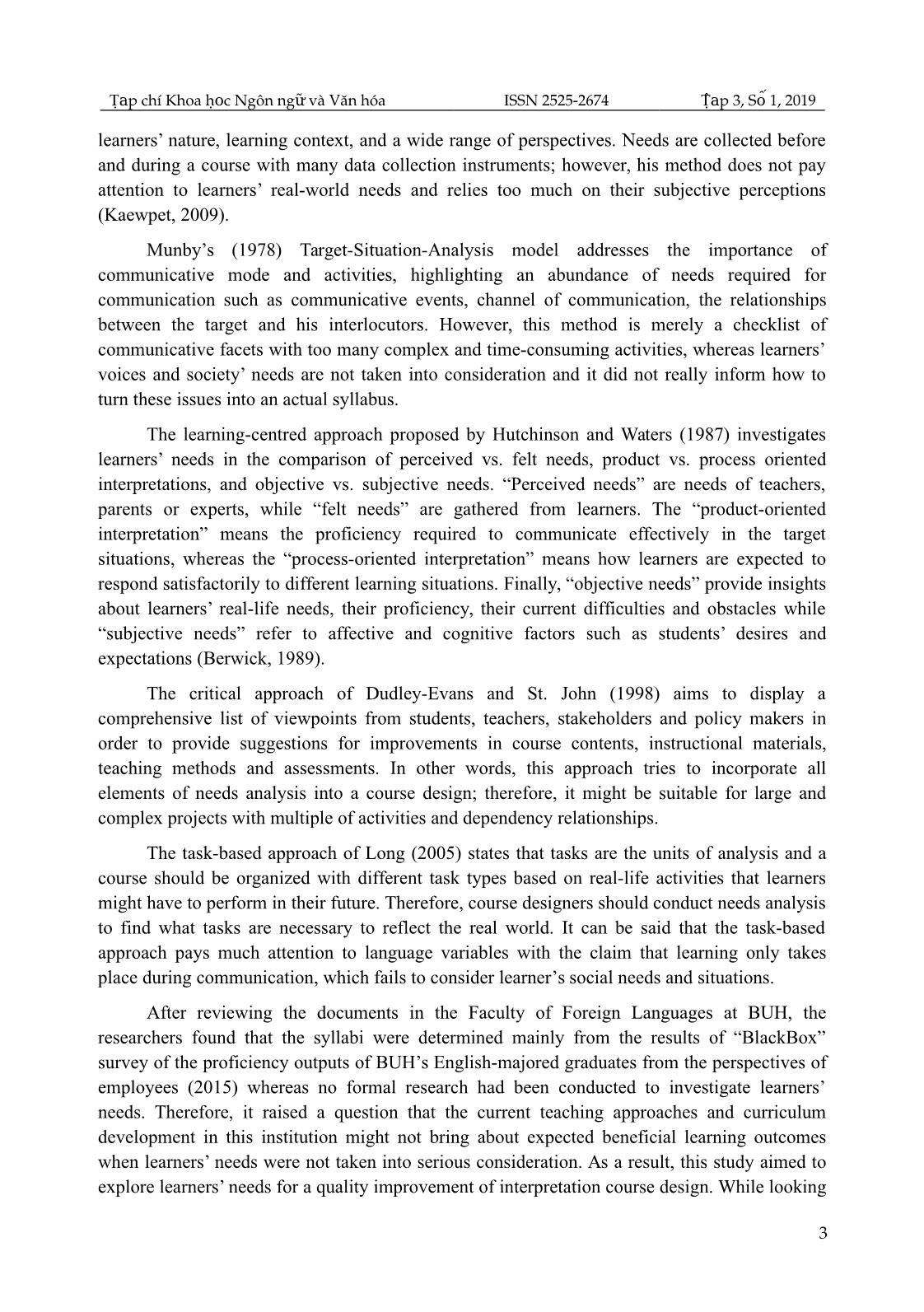
Trang 3
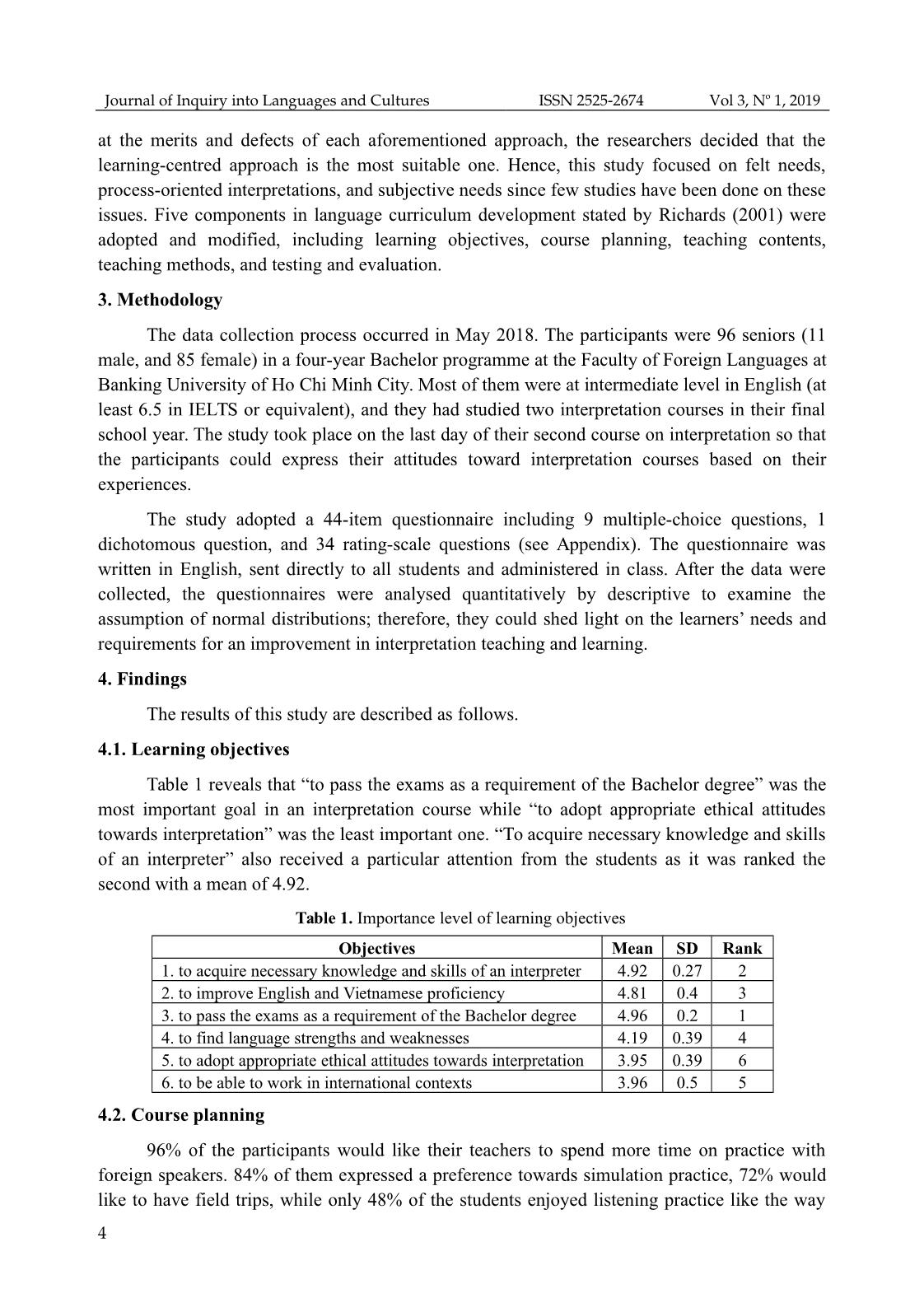
Trang 4
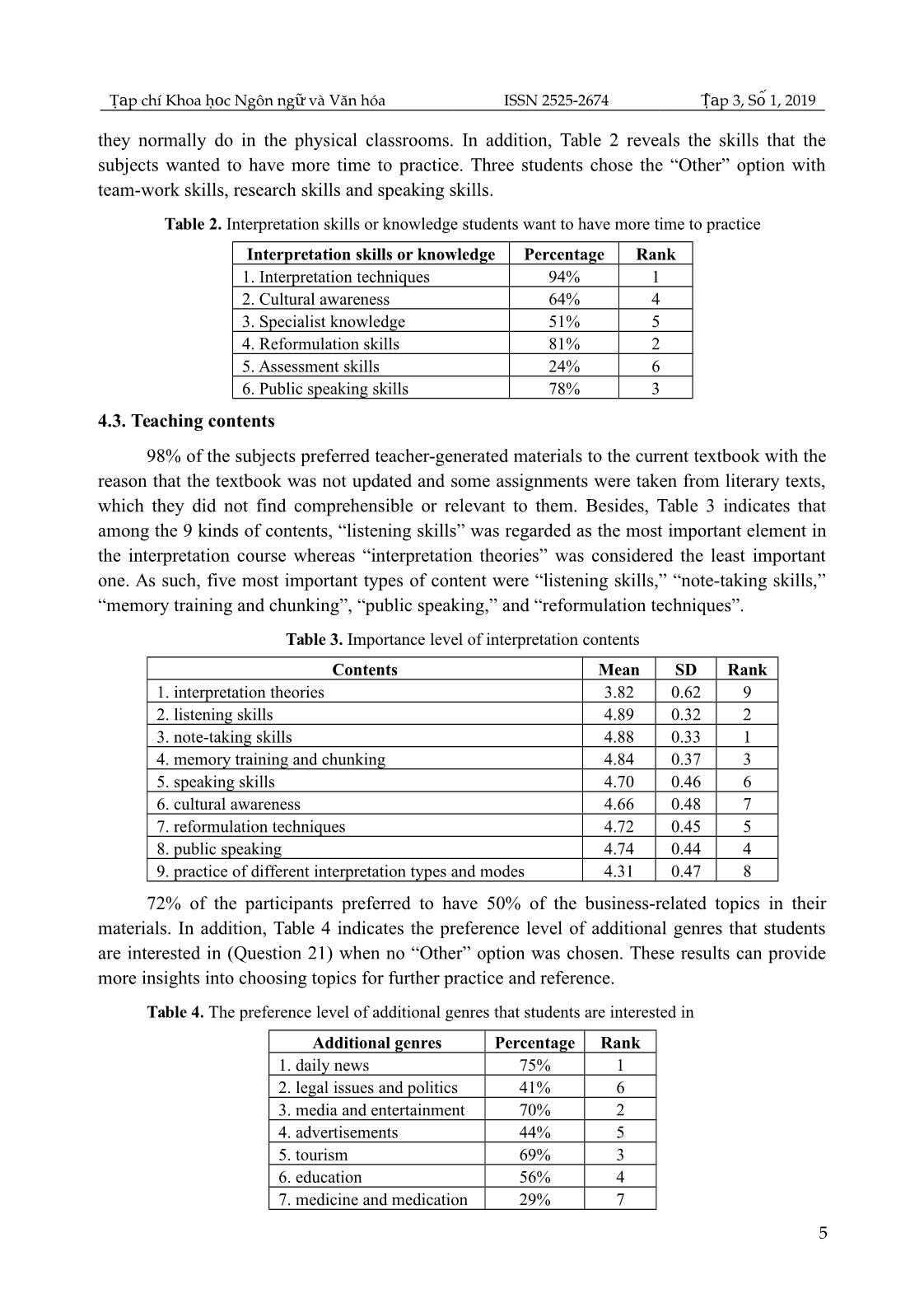
Trang 5
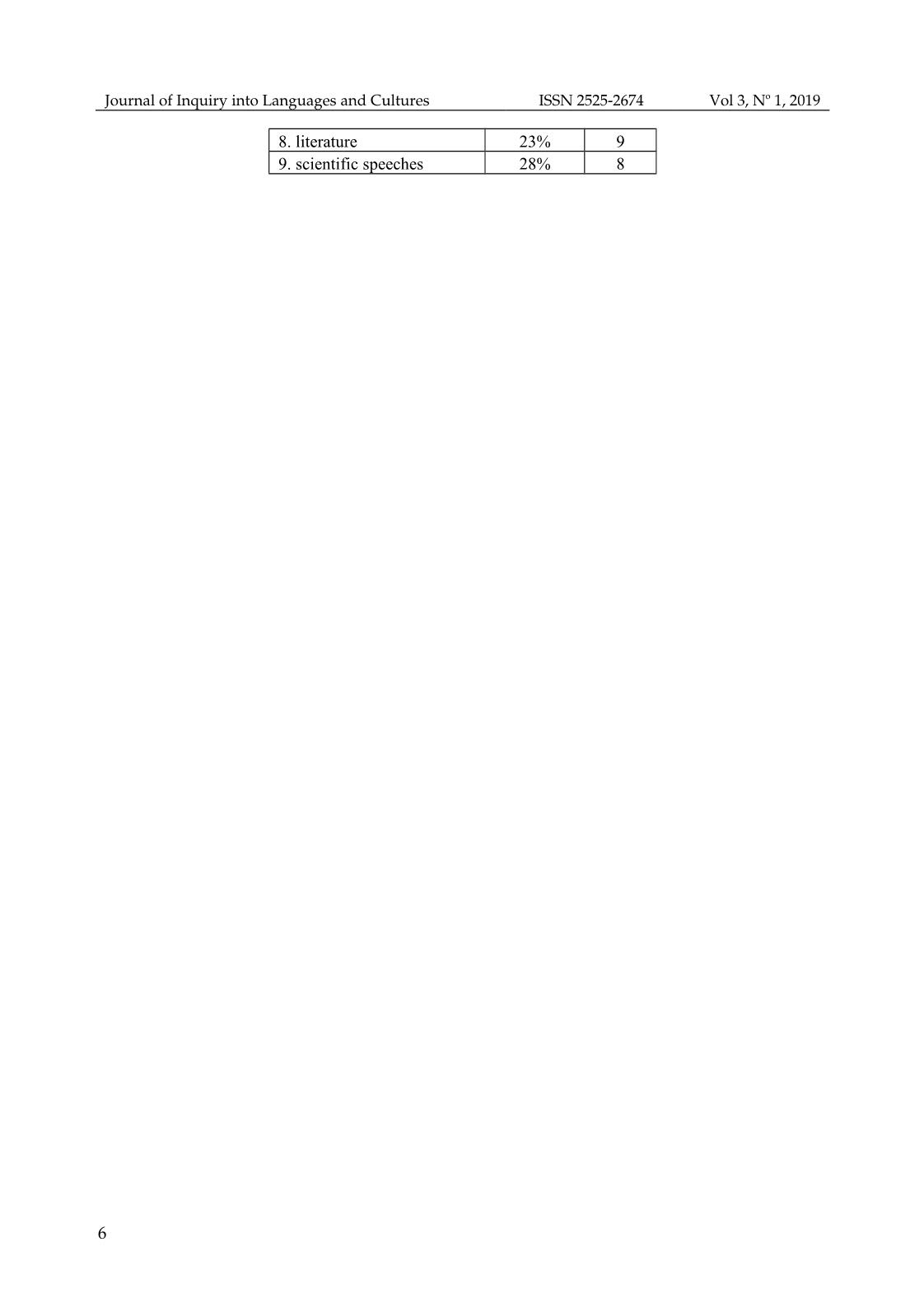
Trang 6
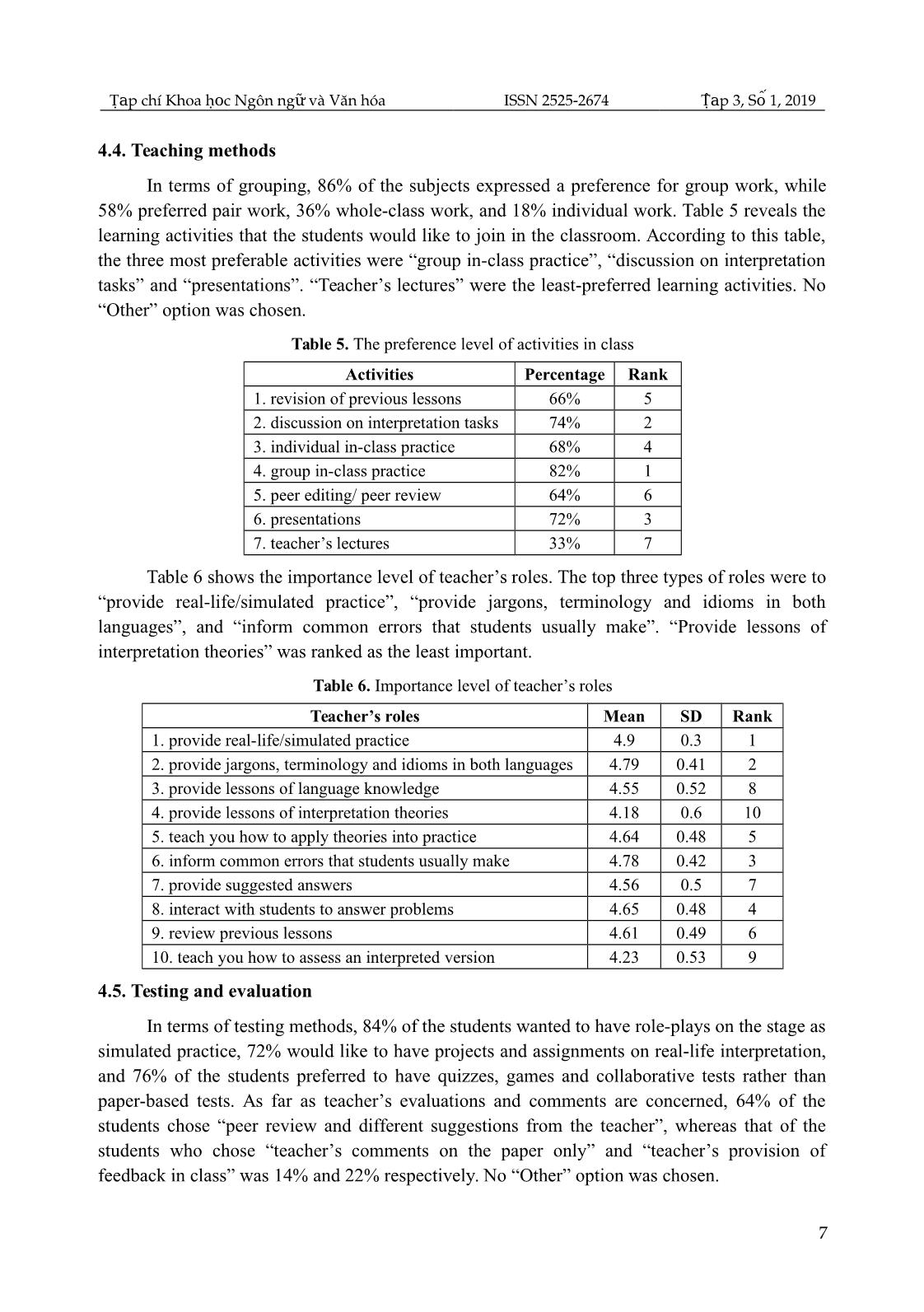
Trang 7
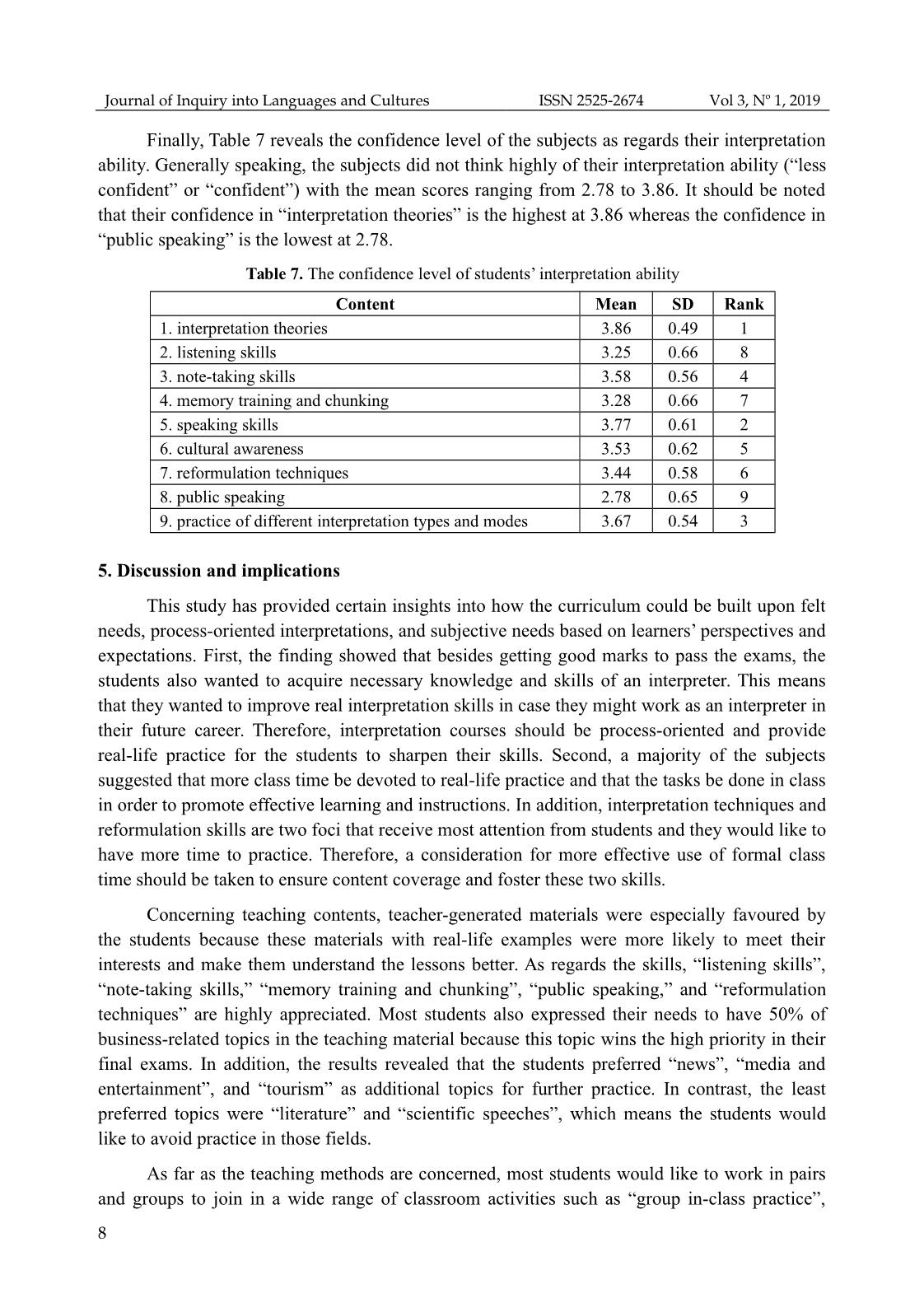
Trang 8
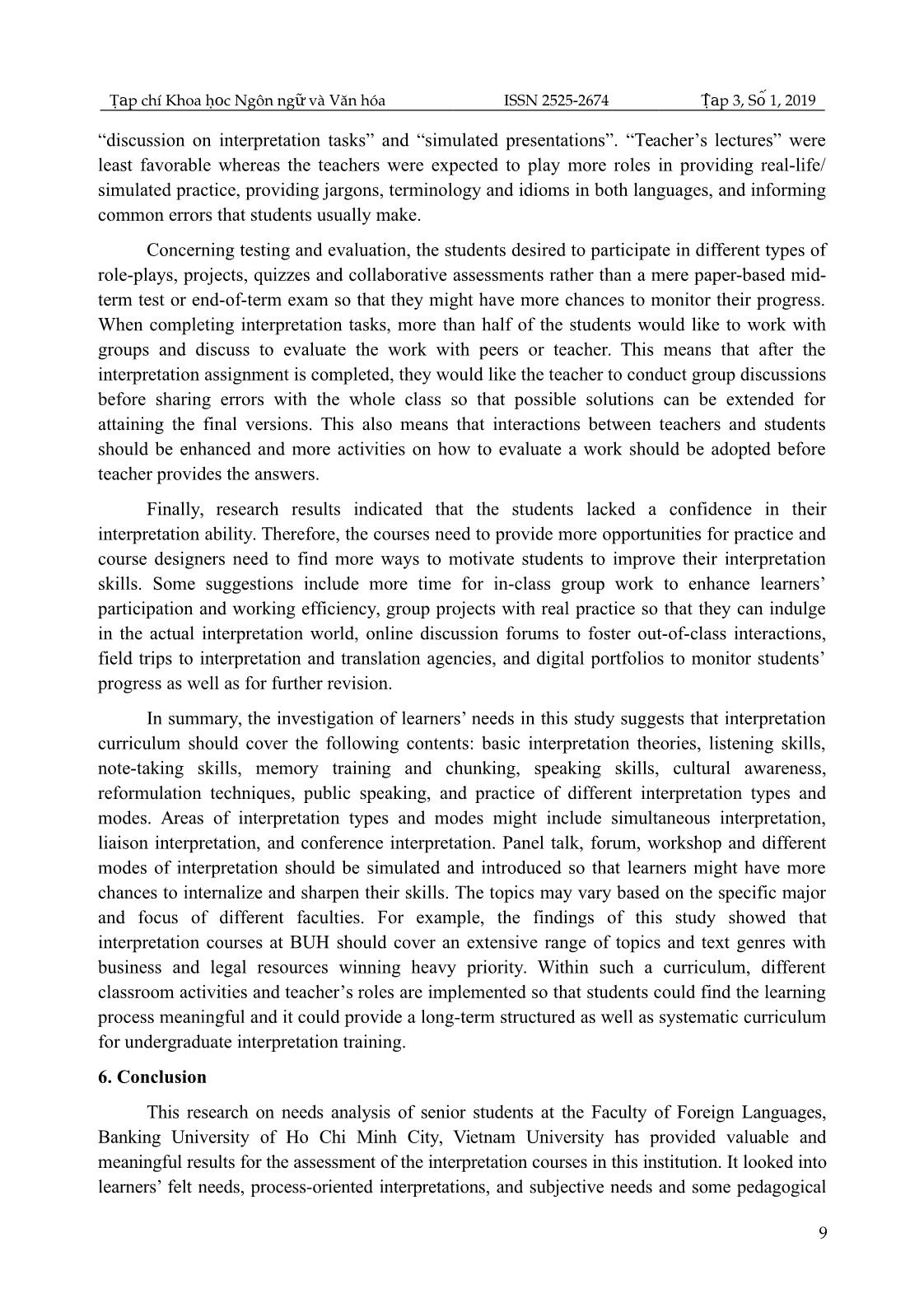
Trang 9
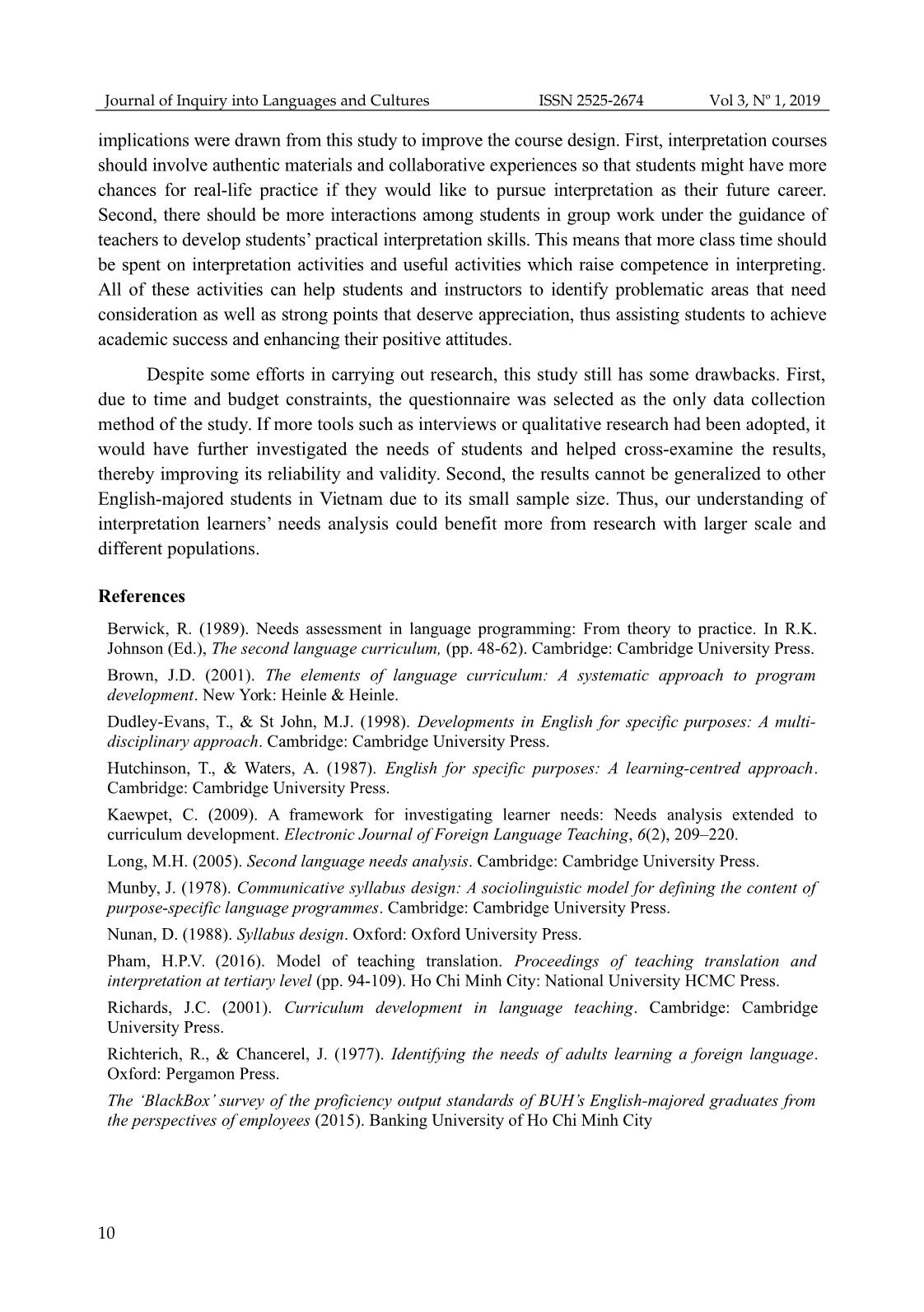
Trang 10
Tải về để xem bản đầy đủ
Tóm tắt nội dung tài liệu: Analyzing undergraduates’ needs for an improvement in interpreter training curriculum at banking university HCMC, Vietnam
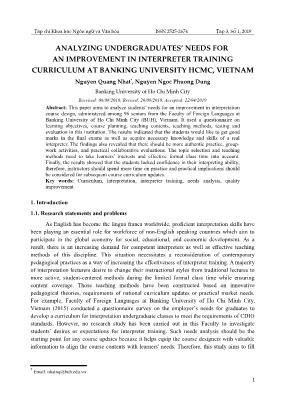
level of additional genres that students are interested in (Question 21) when no “Other” option was chosen. These results can provide more insights into choosing topics for further practice and reference. Table 4. The preference level of additional genres that students are interested in Additional genres Percentage Rank 1. daily news 75% 1 2. legal issues and politics 41% 6 3. media and entertainment 70% 2 4. advertisements 44% 5 5. tourism 69% 3 6. education 56% 4 7. medicine and medication 29% 7 5 Journal of Inquiry into Languages and Cultures ISSN 25252674 Vol 3, No 1, 2019 8. literature 23% 9 9. scientific speeches 28% 8 6 T p chí Khoa h c Ngôn ng và Văn hóaạ ọ ữ ISSN 25252674 T p 3, S 1, 2019ậ ố 4.4. Teaching methods In terms of grouping, 86% of the subjects expressed a preference for group work, while 58% preferred pair work, 36% whole-class work, and 18% individual work. Table 5 reveals the learning activities that the students would like to join in the classroom. According to this table, the three most preferable activities were “group in-class practice”, “discussion on interpretation tasks” and “presentations”. “Teacher’s lectures” were the least-preferred learning activities. No “Other” option was chosen. Table 5. The preference level of activities in class Activities Percentage Rank 1. revision of previous lessons 66% 5 2. discussion on interpretation tasks 74% 2 3. individual in-class practice 68% 4 4. group in-class practice 82% 1 5. peer editing/ peer review 64% 6 6. presentations 72% 3 7. teacher’s lectures 33% 7 Table 6 shows the importance level of teacher’s roles. The top three types of roles were to “provide real-life/simulated practice”, “provide jargons, terminology and idioms in both languages”, and “inform common errors that students usually make”. “Provide lessons of interpretation theories” was ranked as the least important. Table 6. Importance level of teacher’s roles Teacher’s roles Mean SD Rank 1. provide real-life/simulated practice 4.9 0.3 1 2. provide jargons, terminology and idioms in both languages 4.79 0.41 2 3. provide lessons of language knowledge 4.55 0.52 8 4. provide lessons of interpretation theories 4.18 0.6 10 5. teach you how to apply theories into practice 4.64 0.48 5 6. inform common errors that students usually make 4.78 0.42 3 7. provide suggested answers 4.56 0.5 7 8. interact with students to answer problems 4.65 0.48 4 9. review previous lessons 4.61 0.49 6 10. teach you how to assess an interpreted version 4.23 0.53 9 4.5. Testing and evaluation In terms of testing methods, 84% of the students wanted to have role-plays on the stage as simulated practice, 72% would like to have projects and assignments on real-life interpretation, and 76% of the students preferred to have quizzes, games and collaborative tests rather than paper-based tests. As far as teacher’s evaluations and comments are concerned, 64% of the students chose “peer review and different suggestions from the teacher”, whereas that of the students who chose “teacher’s comments on the paper only” and “teacher’s provision of feedback in class” was 14% and 22% respectively. No “Other” option was chosen. 7 Journal of Inquiry into Languages and Cultures ISSN 25252674 Vol 3, No 1, 2019 Finally, Table 7 reveals the confidence level of the subjects as regards their interpretation ability. Generally speaking, the subjects did not think highly of their interpretation ability (“less confident” or “confident”) with the mean scores ranging from 2.78 to 3.86. It should be noted that their confidence in “interpretation theories” is the highest at 3.86 whereas the confidence in “public speaking” is the lowest at 2.78. Table 7. The confidence level of students’ interpretation ability Content Mean SD Rank 1. interpretation theories 3.86 0.49 1 2. listening skills 3.25 0.66 8 3. note-taking skills 3.58 0.56 4 4. memory training and chunking 3.28 0.66 7 5. speaking skills 3.77 0.61 2 6. cultural awareness 3.53 0.62 5 7. reformulation techniques 3.44 0.58 6 8. public speaking 2.78 0.65 9 9. practice of different interpretation types and modes 3.67 0.54 3 5. Discussion and implications This study has provided certain insights into how the curriculum could be built upon felt needs, process-oriented interpretations, and subjective needs based on learners’ perspectives and expectations. First, the finding showed that besides getting good marks to pass the exams, the students also wanted to acquire necessary knowledge and skills of an interpreter. This means that they wanted to improve real interpretation skills in case they might work as an interpreter in their future career. Therefore, interpretation courses should be process-oriented and provide real-life practice for the students to sharpen their skills. Second, a majority of the subjects suggested that more class time be devoted to real-life practice and that the tasks be done in class in order to promote effective learning and instructions. In addition, interpretation techniques and reformulation skills are two foci that receive most attention from students and they would like to have more time to practice. Therefore, a consideration for more effective use of formal class time should be taken to ensure content coverage and foster these two skills. Concerning teaching contents, teacher-generated materials were especially favoured by the students because these materials with real-life examples were more likely to meet their interests and make them understand the lessons better. As regards the skills, “listening skills”, “note-taking skills,” “memory training and chunking”, “public speaking,” and “reformulation techniques” are highly appreciated. Most students also expressed their needs to have 50% of business-related topics in the teaching material because this topic wins the high priority in their final exams. In addition, the results revealed that the students preferred “news”, “media and entertainment”, and “tourism” as additional topics for further practice. In contrast, the least preferred topics were “literature” and “scientific speeches”, which means the students would like to avoid practice in those fields. As far as the teaching methods are concerned, most students would like to work in pairs and groups to join in a wide range of classroom activities such as “group in-class practice”, 8 T p chí Khoa h c Ngôn ng và Văn hóaạ ọ ữ ISSN 25252674 T p 3, S 1, 2019ậ ố “discussion on interpretation tasks” and “simulated presentations”. “Teacher’s lectures” were least favorable whereas the teachers were expected to play more roles in providing real-life/ simulated practice, providing jargons, terminology and idioms in both languages, and informing common errors that students usually make. Concerning testing and evaluation, the students desired to participate in different types of role-plays, projects, quizzes and collaborative assessments rather than a mere paper-based mid- term test or end-of-term exam so that they might have more chances to monitor their progress. When completing interpretation tasks, more than half of the students would like to work with groups and discuss to evaluate the work with peers or teacher. This means that after the interpretation assignment is completed, they would like the teacher to conduct group discussions before sharing errors with the whole class so that possible solutions can be extended for attaining the final versions. This also means that interactions between teachers and students should be enhanced and more activities on how to evaluate a work should be adopted before teacher provides the answers. Finally, research results indicated that the students lacked a confidence in their interpretation ability. Therefore, the courses need to provide more opportunities for practice and course designers need to find more ways to motivate students to improve their interpretation skills. Some suggestions include more time for in-class group work to enhance learners’ participation and working efficiency, group projects with real practice so that they can indulge in the actual interpretation world, online discussion forums to foster out-of-class interactions, field trips to interpretation and translation agencies, and digital portfolios to monitor students’ progress as well as for further revision. In summary, the investigation of learners’ needs in this study suggests that interpretation curriculum should cover the following contents: basic interpretation theories, listening skills, note-taking skills, memory training and chunking, speaking skills, cultural awareness, reformulation techniques, public speaking, and practice of different interpretation types and modes. Areas of interpretation types and modes might include simultaneous interpretation, liaison interpretation, and conference interpretation. Panel talk, forum, workshop and different modes of interpretation should be simulated and introduced so that learners might have more chances to internalize and sharpen their skills. The topics may vary based on the specific major and focus of different faculties. For example, the findings of this study showed that interpretation courses at BUH should cover an extensive range of topics and text genres with business and legal resources winning heavy priority. Within such a curriculum, different classroom activities and teacher’s roles are implemented so that students could find the learning process meaningful and it could provide a long-term structured as well as systematic curriculum for undergraduate interpretation training. 6. Conclusion This research on needs analysis of senior students at the Faculty of Foreign Languages, Banking University of Ho Chi Minh City, Vietnam University has provided valuable and meaningful results for the assessment of the interpretation courses in this institution. It looked into learners’ felt needs, process-oriented interpretations, and subjective needs and some pedagogical 9 Journal of Inquiry into Languages and Cultures ISSN 25252674 Vol 3, No 1, 2019 implications were drawn from this study to improve the course design. First, interpretation courses should involve authentic materials and collaborative experiences so that students might have more chances for real-life practice if they would like to pursue interpretation as their future career. Second, there should be more interactions among students in group work under the guidance of teachers to develop students’ practical interpretation skills. This means that more class time should be spent on interpretation activities and useful activities which raise competence in interpreting. All of these activities can help students and instructors to identify problematic areas that need consideration as well as strong points that deserve appreciation, thus assisting students to achieve academic success and enhancing their positive attitudes. Despite some efforts in carrying out research, this study still has some drawbacks. First, due to time and budget constraints, the questionnaire was selected as the only data collection method of the study. If more tools such as interviews or qualitative research had been adopted, it would have further investigated the needs of students and helped cross-examine the results, thereby improving its reliability and validity. Second, the results cannot be generalized to other English-majored students in Vietnam due to its small sample size. Thus, our understanding of interpretation learners’ needs analysis could benefit more from research with larger scale and different populations. References Berwick, R. (1989). Needs assessment in language programming: From theory to practice. In R.K. Johnson (Ed.), The second language curriculum, (pp. 48-62). Cambridge: Cambridge University Press. Brown, J.D. (2001). The elements of language curriculum: A systematic approach to program development. New York: Heinle & Heinle. Dudley-Evans, T., & St John, M.J. (1998). Developments in English for specific purposes: A multi- disciplinary approach. Cambridge: Cambridge University Press. Hutchinson, T., & Waters, A. (1987). English for specific purposes: A learning-centred approach. Cambridge: Cambridge University Press. Kaewpet, C. (2009). A framework for investigating learner needs: Needs analysis extended to curriculum development. Electronic Journal of Foreign Language Teaching, 6(2), 209–220. Long, M.H. (2005). Second language needs analysis. Cambridge: Cambridge University Press. Munby, J. (1978). Communicative syllabus design: A sociolinguistic model for defining the content of purpose-specific language programmes. Cambridge: Cambridge University Press. Nunan, D. (1988). Syllabus design. Oxford: Oxford University Press. Pham, H.P.V. (2016). Model of teaching translation. Proceedings of teaching translation and interpretation at tertiary level (pp. 94-109). Ho Chi Minh City: National University HCMC Press. Richards, J.C. (2001). Curriculum development in language teaching. Cambridge: Cambridge University Press. Richterich, R., & Chancerel, J. (1977). Identifying the needs of adults learning a foreign language. Oxford: Pergamon Press. The ‘BlackBox’ survey of the proficiency output standards of BUH’s English-majored graduates from the perspectives of employees (2015). Banking University of Ho Chi Minh City 10 T p chí Khoa h c Ngôn ng và Văn hóaạ ọ ữ ISSN 25252674 T p 3, S 1, 2019ậ ố PHÂN TÍCH NHU C U C A SINH VIÊN Đ C I THI N Ầ Ủ Ể Ả Ệ CH NG TRÌNH ĐÀO T O PHIÊN D CH ƯƠ Ạ Ị T I TR NG Đ I H C NGÂN HÀNG TP. HCM, VI T NAMẠ ƯỜ Ạ Ọ Ệ Tóm tắt: Bài viết phân tích nhu cầu của 96 sinh viên năm cuối Khoa Ngoại ngữ tại Đại học Ngân hàng Thành phố Hồ Chí Minh (BUH), Việt Nam để cải tiến hiệu quả xây dựng chương trình môn học phiên dịch. Nhóm tác giả sử dụng bảng câu hỏi khảo sát về mục tiêu học tập, quy hoạch khóa học, nội dung giảng dạy, phương pháp giảng dạy, kiểm tra và đánh giá tại cơ sở giáo dục này. Kết quả cho thấy sinh viên mong đạt điểm cao trong kỳ thi cuối khóa cũng như muốn có được kiến thức và kỹ năng cần thiết của một phiên dịch viên thực thụ. Nghiên cứu cũng chỉ ra rằng rằng cần có nhiều bài tập thực hành gắn với thực tế hơn, cần nhiều hơn nữa các hoạt động học tập nhóm và đánh giá bản dịch thiết thực. Đề tài và phương pháp dạy học cần phải quan tâm đến sở thích của người học cũng như làm sao để việc sử dụng thời gian học tập trên lớp được phát huy một cách hiệu quả. Cuối cùng, kết quả cho thấy rằng sinh viên thiếu tự tin vào khả năng phiên dịch của bản thân mình; do đó, giảng viên nên dành nhiều thời gian hơn vào thực hành và những đề xuất mang tính thực tiễn cần được xem xét để cập nhật trong chương trình giảng dạy tiếp theo. Từ khóa: Chương trình học, phiên dịch, đào tạo phiên dịch, phân tích nhu cầu, cải tiến chất lượng 11
File đính kèm:
 analyzing_undergraduates_needs_for_an_improvement_in_interpr.pdf
analyzing_undergraduates_needs_for_an_improvement_in_interpr.pdf

